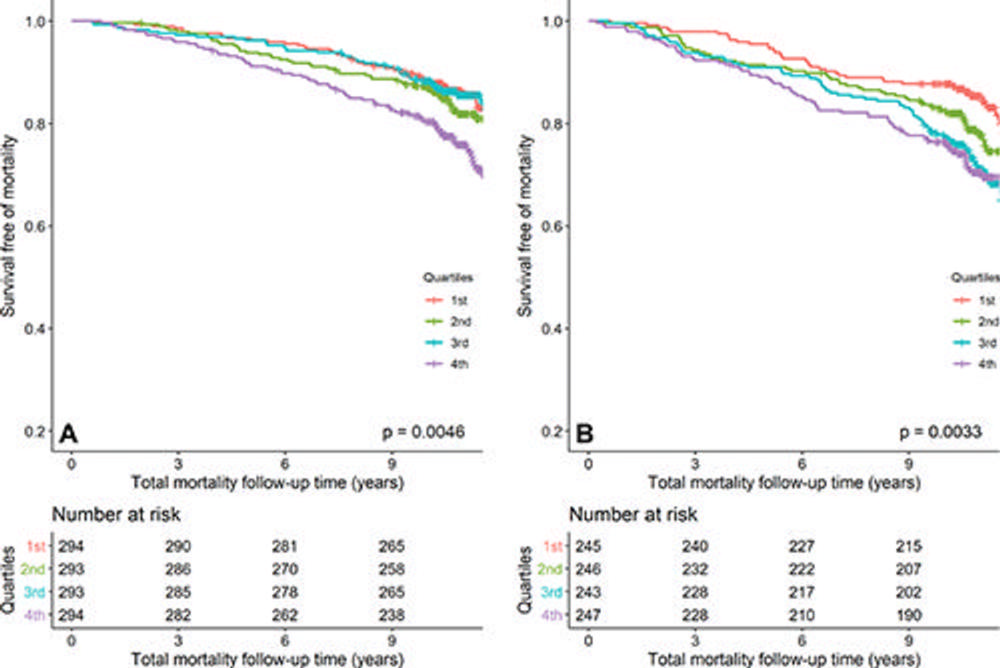Increased Aortic Diameter Raises Risk of Heart Attack, Stroke
Released: April 12, 2022
At A Glance
- The diameter of the thoracic aorta is a biomarker for heart attacks and other adverse cardiovascular events in women and men.
- Researchers assessed data in 2,178 participants who underwent multi-detector CT scans between 2003 and 2006 and were followed for nine years, on average.
- In women, greater ascending aortic diameter was associated with 33% higher cardiovascular mortality risk.
- RSNA Media Relations
1-630-590-7762
media@rsna.org - Linda Brooks
1-630-590-7738
lbrooks@rsna.org - Imani Harris
1-630-481-1009
iharris@rsna.org
OAK BROOK, Ill. — The diameter of the thoracic aorta is a biomarker for heart attacks and other adverse cardiovascular events in women and men, according to a new study published in the journal Radiology.
The aorta is a large artery that carries oxygenated blood to the heart and other parts of the body. The portion that passes through the chest, known as the thoracic aorta, is divided into an ascending aorta that rises from the left ventricle of the heart and a descending aorta in the back of the chest.
The thoracic aorta grows as we age, but changes of vessel size and structure, a phenomenon known as vascular remodeling, have a systemic nature involving hemodynamic—basic measures of cardiovascular function and blood circulation—and biological processes that are also linked to cardiovascular disease.
"While enlargement of the thoracic aorta is a frequent finding in clinical practice, few longitudinal data regarding its long-term prognosis for major cardiovascular disease outcomes at the population level exist," said study senior author Maryam Kavousi M.D., Ph.D., from the Department of Epidemiology at Erasmus MC, University Medical Center Rotterdam in Rotterdam, the Netherlands.
Dr. Kavousi and colleagues assessed these associations in 2,178 participants from the population-based Rotterdam Study. Participants underwent multi-detector CT scans between 2003 and 2006 and were followed for nine years, on average. Thoracic aorta diameters were indexed for body mass index (BMI).
Larger BMI-indexed ascending and descending thoracic aortic diameters were significantly associated with increased risk of adverse cardiovascular outcomes like stroke and death in both women and men.
"Our results suggest that imaging-based assessment of diameter of thoracic aorta can be considered as a risk marker for future cardiovascular disease," Dr. Kavousi said.
In women, greater ascending aortic diameter was associated with 33% higher cardiovascular mortality risk. Remodeling of the aging aorta seems to be different between women and men with faster deterioration in women.
"Aging could affect aortic health and structure more adversely in women than in men," Dr. Kavousi said.
The study findings suggest that cardiovascular risk assessment associated with thoracic aortic size among asymptomatic women and men could lead to effective, sex-specific prevention strategies.
"As the aortic diameter is significantly related to body size, use of aortic diameters indexed for body measurements could improve its prognostic value for cardiovascular outcomes," Dr. Kavousi said.
Thoracic aorta size assessment could easily be added to existing screening methods, the researchers said. The cardiac CT scans deployed in the study are already commonly used to assess coronary calcium. Thoracic aortic diameter could also be measured routinely, for example as part of CT-based lung cancer screening.
The current study was based on a single CT-based assessment of thoracic aorta among a large group of participants from the general population, followed up for nine years for incidence of cardiovascular outcomes and mortality. The researchers have recently repeated the CT-based assessment of thoracic aorta among these participants after a median of 14 years.
"This provides an exciting and unique opportunity to study sex-specific risk profiles and patterns of growth in thoracic aorta in the general population," Dr. Kavousi said.
"Thoracic Aortic Diameter and Cardiovascular Events and Mortality among Women and Men." Collaborating with Dr. Kavousi were Oscar L. Rueda-Ochoa, M.D., Ph.D., Lidia R. Bons, M.D., Ph.D., Fang Zhu, M.P.H., Sofie Rohde, B.Sc., Khalid El Ghoul, B.Sc., Ricardo P. J. Budde, M.D., Ph.D., M. Kamran Ikram, M.D., Ph.D., Jaap W. Deckers, M.D., Ph.D., Meike W. Vernooij, M.D., Ph.D., Oscar H. Franco, M.D., Ph.D., Aad van der Lugt, M.D., Ph.D., Daniel Bos, M.D., Ph.D., and Jolien W. Roos-Hesselink, M.D., Ph.D.
Radiology is edited by David A. Bluemke, M.D., Ph.D., University of Wisconsin School of Medicine and Public Health, Madison, Wisconsin, and owned and published by the Radiological Society of North America, Inc. (https://pubs.rsna.org/journal/radiology)
RSNA is an association of radiologists, radiation oncologists, medical physicists and related scientists promoting excellence in patient care and health care delivery through education, research and technologic innovation. The Society is based in Oak Brook, Illinois. (RSNA.org)
For patient-friendly information on cardiac CT, visit RadiologyInfo.org.

Figure 1. Kaplan–Meier survival curves of incident adverse events across quartiles of body mass index (BMI)–indexed ascending aortic (AA) diameter in women and men. (A) BMI-indexed AA diameter and total mortality in women. (B) BMI-indexed AA diameter and total mortality in men.
High-res (TIF) version
(Right-click and Save As)

Figure 2. Kaplan–Meier survival curves of incident adverse events across quartiles of body mass index (BMI)–indexed descending aortic (DA) diameter in women and men. (A) BMI-indexed DA diter and stroke in women; (B) BMI-indexed DA diameter and cardiovascular mortality in women; (C) BMI-indexed DA amediameter and total mortality in women; (D) BMI-indexed DA diameter and total mortality in men.
High-res (TIF) version
(Right-click and Save As)
